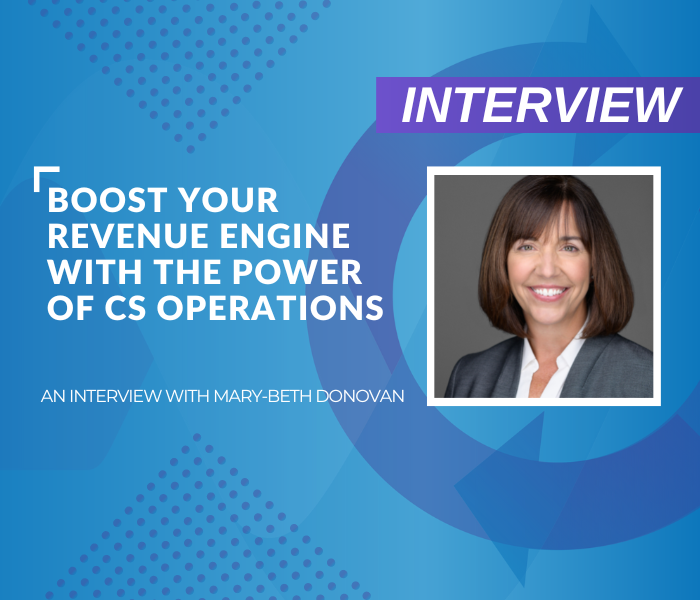The Science & Art Of Customer Success Operations
Continuous changes in technology stacks, market dynamics, pricing models, and economics are constantly threatening your ability to deliver consistent and optimal customer value. In the face of these unceasing challenges, how can you equip your organization to achieve maximum customer value realization? The answer: Customer Success (CS) Operations.
Customer Success Operations is the engine that powers your customer lifecycle with the goal of achieving best-in-class Net Dollar Retention. In order to achieve this recurring revenue utopia, CS Ops, along with all the other functions in your organization, need to perform as a cohesive unit with a holistic view of your entire customer journey.
To help you achieve this organizational unity and operational efficiency, Valuize’s Founder & CEO, Ross Fulton, spoke with CS Operations pioneer, Mary-Beth Donovan. Mary-Beth has been recognized for her expertise in leading Customer Success change management through business transformation from perpetual licensing to the subscription model, influencing adoption of recurring revenue best practices, building strong teams, and designing operational frameworks in industry-leading technology enterprises. In this interview, Mary-Beth shares her expertise on how you can build a powerful CS Operations function that propels your entire organization towards market-leading Net Dollar Retention.
Q: For those who are still wrapping their heads around the nature of CS Operations, what would you say are the key duties and accountabilities of CS Operations?
A: “In early days of Customer Success, CS Operations was tool-led, meaning acquire the technology and execute delivery. In reality, it is so much more. CS Ops is about people, roles and responsibilities and having processes associated with those roles and responsibilities, data, and the systems to enable automation and scale.
CS Operations powers Post-Sales engagement – I call it the Customer Success engine because it truly is a revenue-generating function. That is what this practice has evolved into and it’s also what’s resulted in the enormous growth of the discipline. To properly fuel that engine, you need to build a best-in-class team based on distinct capabilities. Importantly, you need to clearly outline your customer journey and the analytics that correspond with the milestones of customer value along that journey. This data is vital to delivering a prescriptive customer lifecycle motion. To drive your CS roles and responsibilities, you need a dedicated team that’s building the playbooks and processes to make your organization more effective and efficient. This team needs to be able to leverage customer data so that they can guide prescriptive and proactive engagements, get ahead of risk, and identify new opportunities. Don’t forget about your Systems team that implements your Customer Success platform, like Gainsight. This team is critical as they take these leading and lagging indicators from your Customer Insights and Delivery teams and bring everything together into the system to enable streamlined engagement activities, operational efficiency and centralized reporting.”
Q: CS Operations shouldn’t be designing and engineering the strategy, data and insights in isolation. What should the partnership between CS Operations and other functions in the business ideally look like?
A: “I agree, it can’t be done in a silo. In order for CS Operations to be successful, the entire organization has to work together with a cross-functional customer-centric mindset.
I’ll start with Finance because, in the subscription economy, it’s all about driving the valuation of your business. As a first step, you must align with your Finance team on measures and metrics; What are the ARR Growth targets? What are your Net New growth measures? What are your Net Retention, Gross Retention and Renewal Rate targets? That’s where you have to start.
To truly drive operational efficiency, you also have to work with your sister organization in Sales and Service Operations; make sure you have a strong relationship with well-defined responsibilities and accountabilities. It’s critical that these functions are clearly aligned on customer value realization so that your teams have a shared talk track that delivers a seamless experience for the customer from Pre-Sales to Post-Sales. At the land phase, you need to implement a frictionless handoff, automate knowledge transfer, and find the best way to transfer the conversation that the customer is having in the Sales stage to the Customer Success team in Post-Sales. You don’t want to revisit the same story and ask the customer to explain their key goals and desired outcomes over and over again.
All of that requires two additional partnerships within your organizational ecosystem: Marketing and Product. As CS leaders, we need to get better at creating content that drives the Post-Sales experience for customers who want a guided or no-touch experience. Most customers want no-touch experiences to a degree, but many are also willing to pay for a high-touch model because it provides a more personalized experience. Regardless of the account, you should establish a baseline for a guided experience, which is where your relationship with Marketing comes into play. The Marketing team creates valuable content that Customer Success can easily expand on and leverage throughout the customer journey, leading to operational efficiency. When it comes to Product, it’s essential that you work cross-functionally to collaborate on adoption definitions and share insights into customer usage, feedback and engagement. Together, Product and Customer Success can turn these significant customer insights into product enhancements and improvements for our customers.”
Q: What are some of the challenges associated with enabling CS Operations to partner with the broader business, and how can leaders overcome these?
A: “From the top-down, you have to begin by answering; why are we here? What is the business going to invest in? CS Operations is an investment, especially in a subscription transition – you have to influence margins and manage growth, which is a very tricky balance to strike. As is the case with most early-stage CS Operations functions, you’re going to start with a lean Operations team and you will have to garner the investment to manage and scale the team as you grow.
Ultimately, you need to ensure that there’s an aligned strategy and a programmatic plan that outlines how your organization will achieve growth, scale and operational efficiency. CS Operations is a transformation program – it isn’t a single year process or one-and-done function. Goals and priorities may shift every year, but without a clear focus on the overarching strategy, the programmatic approach and the required change management to bring people along, you won’t get far. I think that’s the most critical first step or failure, because if people don’t understand why we’re here and what we’re trying to do, they won’t be motivated to change their behavior.”
Q: How can leaders showcase the value of CS Operations to Senior Leadership and the entire organization?
A: “Consider how you run the business for your Senior Leadership team and organizational peers. I think it’s wise to implement a weekly, monthly and quarterly business review process, where you’re regularly forecasting revenue retention metrics with other leaders in the business. For example, you’ll want to partner with Sales Operations to forecast net new and expansion ARR and start to build out the metrics and cadence around Net Retention, Gross Retention, and Renewals. Sales Operations and CS Operations are sister organizations – they’re very close and intricately linked. I recommend working closely with your Sales Operations leads so that you can piece together your ARR forecast, then cascade your other revenue metrics accordingly.”
Q: How can CS Operations leaders advocate for this partnership to those line of business leaders?
A: “You cannot lead in Customer Success Operations (or any organization, really) by just saying; I need this, period. You have to be able to clearly articulate why you’re there and how everyone fits into the picture. A critical duty in my previous roles was to influence – to tell the CS story and inform other leaders why we’re here and why it’s important. Use your North Star metric (i.e. growth and value realization) to drive this conversation and ensure you can clearly articulate its importance at an operational level. You have to be able to explain this guiding “why” and share what’s in it for them – recurring revenue growth, predictability, stock price, benefits for your customers, and operational efficiency.
When it comes to Sales, it’s about trying to explain that one plus one equals three; focusing Sales to go hunt and farm while the Success team is there to drive adoption and consumption, nurture customer value and identify new opportunities, there’s operational efficiency, value add and opportunities for both teams. So much of what we have to do is to find out who needs to be influenced, have those conversations and always lead with; here’s where I need to be and here’s where I am today. How can we work together to bridge that chasm?”
Let Operations Lead The Way
While CS Operations will be at the helm of designing the strategy, data and insights to drive scalable growth, this critical function can’t operate in isolation. CS Operations needs to partner with other customer-facing functions, from Pre-Sales through to Post-Sales, to enable an optimal customer lifecycle that accelerates operational efficiency and customer value realization. With your entire business acting as a cohesive unit, you’ll boost your ability to drive best-in-class Net Dollar Retention.
For more expert insight into the power of CS Operations, listen to Mary-Beth’s full interview on the Customer Valuecast podcast.






